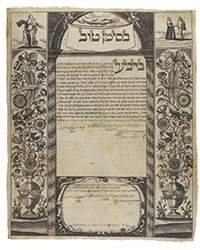Curator Q&A – For Richer For Poorer
with Elizabeth Selby, Curator of For Richer For Poorer: Weddings Unveiled
What is your favourite object in the exhibition?
There are so many! Probably the most intriguing and unique is a ledger that was kept by a shadchan (matchmaker) who was operating in the East End in the 1940s.
It was quite usual for orthodox Jewish couples to have arranged marriages at this time, often through parents but sometimes through a professional matchmaker. The ledger is in Yiddish and includes notes about prospective matches.
We also have some wonderful agreements between kosher caterers and bridal couples for wedding receptions during the inter war period
that illustrate the astonishing amount of food that was served – there was a
constant supply of it throughout the day.
The guests would enjoy a wedding
breakfast or luncheon as well as a formal dinner (often as many as 14 courses)
interspersed with pastries, cakes, sweets and ices. There are stories of guests
“training” for the day by not eating beforehand, and gate crashers were quite
common.
What is the most
unusual object in the exhibition?

Although the main part of the exhibition deals with the
period from the late 19th century until the 1950s, we have a few
older objects that are really fascinating. The oldest object in the exhibition
is a ketubah, or Jewish marriage contract, dating from 1729 (right).
The ketubah was
donated to the museum in 1933 and is quite curious because it’s not only
accompanied by a note written by a rabbi confirming that he married the couple,
but also one from a vicar in Hackney confirming his presence at the wedding.
Although Jewish marriages appear to have been recognised by common law, this
couple may have wanted to make sure that their wedding was at the fullest legal sanction.
What would
surprise visitors about the exhibition?
One thing that surprised me was a more serious
story about how the Jewish community struggled with the idea of “irregular”
marriages. From 1836 the
Board of Deputies of British Jews was appointed to certify Jewish marriage
secretaries and ensure that marriages were performed “according to the usages
of Jews”.
Only synagogues which recognised the authority of the Chief Rabbi in
London or the Sephardi Rabbinate were permitted to appoint a marriage secretary.
Marriages conducted in unauthorised synagogues were
not recognised by law unless a separate civil ceremony also took place.
These
marriages, known as stille huppah (literally
‘silent marriage’) caused considerable concern for the Jewish community. We’ve
got a notice in the exhibition, probably dating from the mid-19th century that would have been hung in a synagogue and warns the community of the
penalties of “irregular” marriage.
It
might also surprise people that despite the poverty experienced in the East End
by much of the community, weddings were huge occasions, often with no expense
spared. Families often got into debt or spent years saving for the
wedding.

Is there anyone
whose story is told in the exhibition that you have found particularly moving?
The exhibition mainly focuses on weddings rather than
married life, but it’s been quite moving thinking about what happened to many
of the couples after they got married. In many of the wedding photos we have,
especially the ones that the East End photographer Boris Bennett took, you
really get a sense of the couple looking forward to a future together.
I was
particularly moved by stories about refugee couples and Holocaust survivors who
got married during or after the war. For them meeting a partner and building a
new life and family together was a really important process in recovering from
trauma.
Who do you think
the exhibition will appeal to?
We’ve
already heard from a lot of people that they are excited about the exhibition –
particularly members of the Jewish community who have their own family stories
to tell, or perhaps their parent’s wedding photograph was taken by Boris and
they want to come and see similar items in the exhibition.
Hopefully the
exhibition will appeal to a wider audience too, as there is a really
interesting and surprising story about how weddings symbolised the aspirations
of the immigrant Jewish community. Weddings are so universal that I think
non-Jewish visitors will be able to relate to many of the stories.